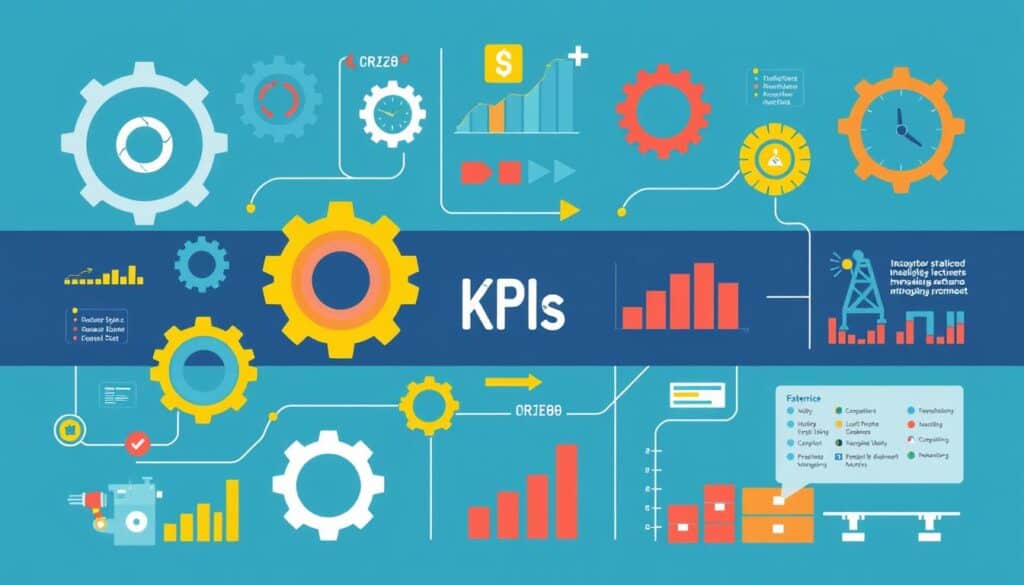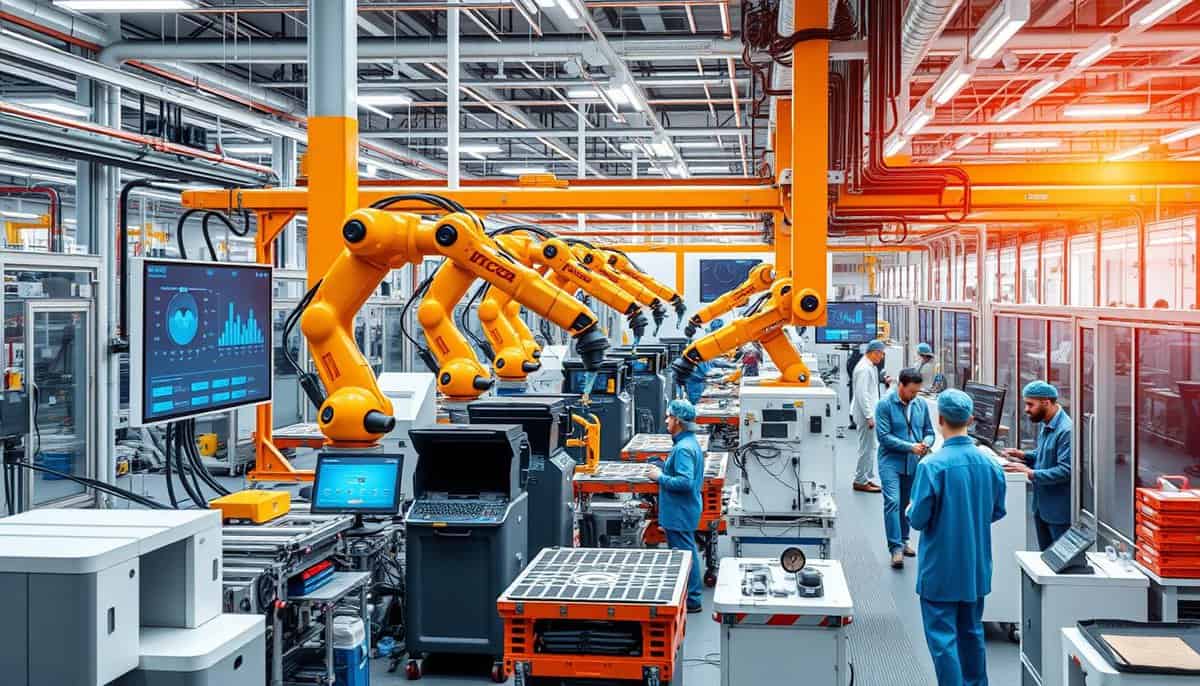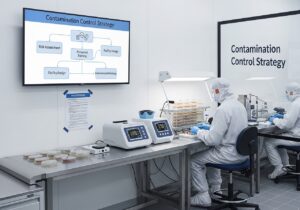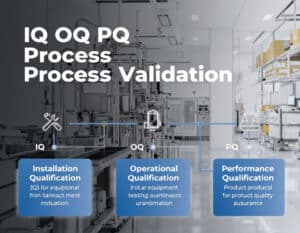Are you making the most of every tool at your disposal to enhance production? Knowing and using the right Key Performance Indicators (KPIs) can change your operation’s success. These metrics help reduce downtime and plan production better, showing every part of the manufacturing process.
KPIs for production are essential in today’s manufacturing world. They help firms monitor, analyze, and improve their production stages. Metrics like Overall Equipment Effectiveness (OEE), Inventory Turns, and On-Time Delivery let businesses spot problems, cut waste, and predict future needs. These indicators guide production towards goals while adapting to market shifts and environmental changes. This makes operations more agile and efficient.
النقاط الرئيسية
- Using KPIs well can greatly improve efficiency in manufacturing.
- Overall Equipment Effectiveness (OEE) blends availability, performance, and quality.
- Low inventory turns can release cash and better meet customer needs.
- On-Time Delivery is key to pleasing customers and encouraging staff.
- Tracking Customer Returns is crucial for fixing issues in production.
What are Production KPIs?
Production Key Performance Indicators (KPIs) are key measures in manufacturing. They track how well and efficiently production processes work. These indicators help companies figure out what’s working and what’s not. This way, they can improve and make their operations smoother.
Definition of Production KPIs
Production KPIs are numbers that show how the production process meets goals. They cover important factors like cycle time, throughput rate, and Overall Equipment Effectiveness (OEE). Tracking these lets companies fine-tune production. It also allows them to measure progress accurately.
Importance of Tracking KPIs
The value of tracking KPIs is huge. They turn lots of data into useful insights. Regular monitoring is key for several reasons:
- Goal setting and achievement: KPIs make it possible to set clear goals. This keeps production lines up with what the company wants.
- Identifying bottlenecks: by looking at KPIs, companies can spot hold-ups in production quickly. This lets them fix issues fast and keep things running smoothly.
- Enhancing production process efficiency: focusing on KPIs helps companies boost their efficiency. This means they can save money and make more products.
Keeping an eye on KPIs gives manufacturers a way to improve their performance. This is crucial to stay ahead in a fast-changing market.
Types of Production KPIs
There are three main types of Production KPIs. They focus on machinery, products, and cost efficiency. Knowing these KPI categories helps in better tracking and improving production processes.

Machinery or Asset Focused
This KPI type looks at machinery and asset management. Important metrics are:
- Machine uptime rate: this measures how long equipment stays operational. The formula is (Total Time Machine Used / Available Production Time) * 100. The goal is to keep the machine uptime rate at 90%.
- Defect rate: this tracks the quality of what’s made. The formula is the Number of Defects / Units Produced * 100. The aim is to lower the Defect Rate.
- Overall Equipment Effectiveness (OEE): this checks how well machinery works. The formula is (Units Produced × max Cycle Time) / Available Production Time. We want to boost OEE by 5% this year.
Unit or Product Focused
Here, KPIs look at the number of units or products, giving insights into how production tracks. Included metrics are:
- Cycle time: this is how long one production cycle takes.
- Production capacity rate: this shows the max amount of output possible. It’s calculated by Machine Capacity Rate * Time.
- Throughput rate: this measures product output over time.
Cost Focused
Cost-focused KPIs help look at money and keeping costs low in production. Key metrics are:
- Production cost per Unit: this measures the cost to make one unit. The formula is Total Manufacturing Cost / Number of Units Produced. The goal is to cut the cost of making a unit by 2 cents by 2022.
- Unit maintenance cost: this looks at upkeep costs per unit. It’s calculated by Total Maintenance Cost / Number of Units Produced. The target is to slash Unit Maintenance costs by 5% this year.
- Unused capacity costs: this checks the cost impact of not using full production capacity. The formula is Percentage of available unused capacity × Total Manufacturing Cost. We aim to reduce unused capacity by 10% over 6 months.
Below is a table showing key metrics in these categories:
| KPI Type | متري | الصيغة | Example Goal |
|---|---|---|---|
| Machinery or Asset Focused | Machine Uptime Rate | (Total Time Machine Used / Available Production Time) * 100 | Keep each machine uptime rate at 90% |
| Unit or Product Focused | Production Capacity Rate | Machine Capacity Rate * Time | Ensure each machine uptime rate is 90% |
| Cost Focused | Production Cost per Unit | Total Manufacturing Cost / Number of Units Produced | Cut unit production cost by 2 cents by 2022 |
مؤشرات الأداء الرئيسية (KPIs) للإنتاج
KPIs for production cover many metrics key for assessing manufacturing efficiency and productivity. These indicators provide data that helps manufacturing leaders make smart choices. They work to optimize operations, lower costs, and boost output. Knowing how to track manufacturing with key metrics is vital to compete today.

Several KPIs measure different aspects of production. They are crucial for quality assurance, equipment upkeep, cost control, and overall productivity. Key production KPIs include:
- Revenue: The total income from sales or services.
- Gross Profit Margin: The revenue percentage after removing the cost of goods sold.
- العائد على الاستثمار (العائد على الاستثمار): The profit to investment ratio.
- Customer Acquisition: The new customers gained within a period.
- Customer Retention: The rate of customers staying over time.
- Employee Satisfaction: How happy employees are in the company.
- Website Traffic: The site visitors count over time.
- Conversion Rate: The share of visitors who perform a desired action.
- Inventory Turnover: How often inventory is sold and replaced.
- Time to Market: The period to launch a new product.
Manufacturing-specific KPIs include:
- Count: The total products made.
- Reject Ratio: The scrap production measure.
- Capacity Utilization: How much production capacity is used.
- Rate: The speed of producing goods.
- Target: Specific goals for production periods.
- وقت: Time needed to complete a task.
- Overall Equipment Effectiveness (OEE): The production equipment’s efficiency.
- Downtime: The time when production equipment is idle.
- Cycle Time: The total time for a full production cycle.
- Lead Time: The time for a product to go through production.
To monitor manufacturing well, finding the most crucial KPIs is key. Setting targets for each KPI, and consistently watching and analyzing KPI data, helps track progress and spot improvement areas. By using these indicators, manufacturers can get better results and stay ahead in the market.
| متري | التعريف |
|---|---|
| OEE | Calculation: Availability x Performance x Quality |
| Total وقت الدورة | Components: Production Time + Inspection Time + Transportation Time + Wait... |
You have read 46% of the article. The rest is for our community. Already a member? تسجيل الدخول
(وأيضًا لحماية المحتوى الأصلي لدينا من روبوتات الكشط)
مجتمع الابتكار العالمي
تسجيل الدخول أو التسجيل (100% مجاناً)
اطلع على بقية هذه المقالة وجميع المحتويات والأدوات الخاصة بالأعضاء فقط.
فقط المهندسون والمصنعون والمصممون والمسوقون الحقيقيون المحترفون.
لا روبوت، ولا كاره، ولا مرسل رسائل غير مرغوب فيها.
التعليمات
What are Production KPIs and why are they important?
Production Key Performance Indicators (KPIs) measure the manufacturing process’s success. They are vital for measuring efficiency, spotting problems, and meeting goals. This boosts the whole operation’s performance.
What types of Production KPIs should be monitored?
There are three types of Production KPIs. These include Machinery or Asset Focused, such as machine uptime. Then there’s Unit or Product Focused, like throughput rate. And the Cost Focused, for example, unit production costs. Keeping an eye on these helps make the production better.
How do you calculate essential Production KPIs?
Calculating Production KPIs uses specific formulas. For Cycle Time, subtract Production Start Time from Production End Time. These calculation methods set clear targets and track improvements.
What are the top Production KPIs to monitor for manufacturing efficiency?
Important KPIs include Cycle Time and Throughput Rate. Also, Production Attainment and Overall Equipment Effectiveness (OEE). They show the manufacturing’s speed, efficiency, and output.
External Links on Production and Quality Optimization
المعايير الدولية
(حرك الرابط لرؤية وصفنا للمحتوى)
مسرد المصطلحات المستخدمة
Cost of Goods Sold (COGS): التكاليف المباشرة المنسوبة إلى إنتاج السلع التي تبيعها الشركة، بما في ذلك المواد والعمالة، باستثناء النفقات غير المباشرة مثل تكاليف التوزيع وتكاليف قوة المبيعات.
Key Performance Indicator (KPI): قيمة قابلة للقياس توضح مدى فعالية المنظمة في تحقيق الأهداف التجارية الرئيسية، وغالبًا ما تستخدم لتقييم النجاح في الوصول إلى الأهداف.
Overall Equipment Effectiveness (OEE): مقياس يُستخدم لتقييم كفاءة عمليات التصنيع، ويُحسب بضرب معدلات التوافر والأداء والجودة. يُحدد هذا المقياس الخسائر، مما يُمكّن من تحسين الإنتاجية وفعالية العمليات.
Return on Investment (ROI): مقياس مالي يستخدم لتقييم ربحية الاستثمار، ويتم حسابه عن طريق قسمة صافي الربح من الاستثمار على التكلفة الأولية، معبرًا عنها كنسبة مئوية.
Specific Measurable Achievable Relevant Timely (SMART): إطار عمل لتحديد الأهداف الواضحة والقابلة للقياس والقابلة للتحقيق والمتوافقة مع الأهداف الأوسع والمحددة بالوقت، مما يسهل التخطيط الفعال وتقييم التقدم.
Takt Time: أقصى وقت مسموح به لإنتاج منتج يلبي طلب العميل، ويُحسب بقسمة وقت الإنتاج المتاح على الناتج المطلوب. يُساعد هذا على مزامنة وتيرة الإنتاج مع الطلب، مما يضمن سير العمل بكفاءة وتخصيص الموارد.



























effectiveness of KPI tracking and decision-making ?
please include more examples of how these KPIs
it could be interesting discussing how integrating real-time data analytics and AI can further enhance the accuracy and effectiveness
Interesting read! But dont you think theres an overemphasis on KPIs? What about the human element in production efficiency?
Interesting read, but dont you think relying heavily on KPIs might stifle creativity and innovation in production?
منشورات ذات صلة
استراتيجية مكافحة التلوث والغرف النظيفة: 26 أفضل الممارسات
من GMP إلى cGMP: دليل الإتقان الكامل
التحقق من صحة عملية IQ OQ PQ: النظرية الكاملة والتطبيق العملي
استراتيجيات "الجوز الوحيد"، و"التابع الأول"، و"التابع السريع"
أفضل 20 استخدامًا للوكلاء في الهندسة
كيفية بيع الثلج للإسكيمو (أو بالأحرى حيل التسويق)